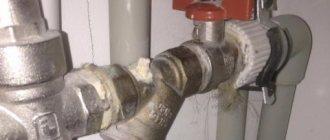Hydrogen sulfide in water: what is it and how does it manifest itself? The unpleasant smell of rotting or “rotten” eggs from water is a serious reason to think about its quality. Tap water goes through various stages of purification before entering the tap, but a well or a well may well present such a “fragrant” surprise. And in this case, the owner of the house will have to take all the work to get rid of the unpleasant odor and prevent poisoning of household members caused by the presence of hydrogen sulfide in water into his own hands. If your water smells like a swamp, look here for the reasons!
Hydrogen sulfide in water: chemical nature
Hydrogen sulfide is a colorless gas with an unpleasant pungent odor of rotten organic matter and a sweetish metallic taste when inhaled. Soluble in water in small proportions. An aqueous solution of H2S exhibits weak acidic properties:
Ka = 6.9 x 10-7 mol/l; pKa = 6.89
The smell of hydrogen sulfide in water can be harmful to the body. Hydrogen sulfide is very poisonous if ingested through the respiratory tract. Even minor concentrations can lead to poisoning of the body, including death.
Mechanical impurities
It’s not at all difficult to clean the smell from the water in the well yourself. Nowadays, removing any garbage is quite simple. First of all, to do this, you need to pump out the entire volume of liquid. Next, you should run the water through high-quality filters. In the process of pumping out and running water, you need to carefully inspect the walls of the well for the presence of cracks in it. If they are identified, they must be sealed with bitumen mastic. The bottom of the well is also inspected, and if necessary, its filter layers are changed.
Why does well water smell like hydrogen sulfide?
Hydrogen sulfide contained in deep water layers passing through sulfide ores is predominantly inorganic in nature. It can be present both in water extracted from deep-sea wells and in surface aquifers. It is a product of the decomposition of metal sulfides, most often FeS, in acidic aqueous solutions.
Hydrogen sulfide (H2S) is produced by sulfobacteria, which are common in underground aquifers. They work as a reducer of sulfates and sulfides dissolved in water to hydrogen sulfide. Most sulfobacteria prefer the anaerobic or anoxic environment of detritus, silt deposits, and artesian water horizons. Some types of sulfate-reducing bacteria - thionic bacteria - thrive in excess oxygen.
Hydrogen sulfide of organic origin is released during the decomposition processes of organic remains of plants and animals. Its toxic concentrations accumulate in drainage ditches, garbage pits, tanning vats, sulfur mines and coal mines.
In the drinking water supply, shallow wells and wells are at risk here, where organic matter can seep out along with the water during floods or heavy rainfalls.
In a well or well, hydrogen sulfide in water can appear as a result of:
- violation of the tightness of the casing: sulfur compounds seep from the soil;
- accumulation of sediment containing sulfur bacteria on the walls and bottom of the water intake pipe;
- sludge contamination of the walls of the water intake pipe and the bottom;
- ingress from groundwater passing through a nearby sulfur formation;
- technogenic pollution of groundwater.
It is important to promptly identify the cause of the smell of hydrogen sulfide from the water and eliminate it.
Household methods for removing hydrogen sulfide from well sources
The main reason for the appearance of hydrogen sulfide is the activity of sulfate-reducing bacteria, which process organic compounds contained in sludge.
Owners who have no idea about the reasons for the appearance of gas with the smell of rotten eggs in water install expensive compressor equipment with large-volume tanks and incur significant financial costs instead of doing the more logical thing, namely, trying to get rid of the source of contamination.
Well pumping
Since colonies of sulfur bacteria multiply well in sludge, feeding on organic compounds, pumping out sludge deposits from the bottom of wells should help get rid of bacteria and, accordingly, hydrogen sulfide.
To do this, the source must be pumped, that is, raised from the bottom to the surface and then removed the silty fractions suspended in the water. At the same time, pumping will increase the well's flow rate and improve the quality of drinking water.
Typically, water sources with hydrogen sulfide are not very deep, so many people use vibrating electric pumps to pump water out.
The water pump is lowered to the bottom and then raised to a distance of 150 - 200 mm, after which pumping begins. To prevent the electric pump from accidentally sinking to the very bottom, you can install a limiter made of a metal strip 150 - 200 mm long.
There are clay deposits at the bottom that have turned into a hard crust, which is the result of a long absence of water intake; they are removed using a special device - a bailer, which is dropped from a great height into the borehole channel. With its sharp teeth, it loosens the rock and carries it piece by piece out of the mine.
An effective method of pumping wells is the reverse supply of water under pressure to the bottom area. This technology is the most productive, since its use not only loosens silt deposits, but also frees clogged casing filters.
Water under pressure can be supplied back to the well source using a deep electric pump raised to the surface or a pumping station.
You can also negotiate with the firefighters and drive a fire truck to the site, which, using a pressure hose lowered to the bottom, will quickly destroy, loosen and mix all clay deposits with water. After reverse pumping, part of the water is poured onto the surface by gravity, and is lifted from the shaft using an inexpensive vibrating electric pump capable of operating in a heavily polluted environment.
Rice. 12 Using a bailer to lift sludge from the bottom
Related article:
Deferrization of water from a well . If your well water smells of hydrogen sulfide and you are wondering what to do, then it may be interesting to read an article where we consider in detail the problem of high iron content in well water in a private water supply and methods for solving the problem.
Characteristic signs that the water in the well contains hydrogen sulfide
The main sign indicating the presence of hydrogen sulfide in water is an unpleasant “rotten” odor and a sweetish taste of water, leaving a metallic aftertaste. However, with a low concentration of hydrogen sulfide in water, it can be difficult to detect the smell. On the contrary, at high levels, H2S blocks the olfactory receptors and can create a false sensation that there is no gas in the water.
If black sediment has accumulated at the bottom of a water source, this also indicates the presence of hydrogen sulfide in the water. The exact concentration of hydrogen sulfide in water can be determined in the laboratory using bacteriological analysis.
Available methods for disinfecting water resources
To choose a purification method, it is necessary to submit the water for analysis at the SES for hydrogen sulfide, permanganate oxidation and other indicators.
If the well smells like a swamp and there is black mud on the walls, this is a sign of anaerobic bacteria.
Before purifying water at a source using complex devices in one way or another, you need to do the following:
- remove deposits from the walls and bottom;
- ensure the tightness of the well casing;
- pour coarse crushed stone onto the bottom, which will serve as a natural filter.
Disinfecting water methods.
To clean an artesian well, you should contact professionals who will remove sediment using special equipment.
Despite the fact that sulfur bacteria die under the influence of ultraviolet radiation, it is not recommended to get rid of them by leaving water in containers in the sun, because other harmful organic bacteria quickly form in the liquid.
If the liquid begins to stink when heated, it means that the boiler or boiler needs to be cleaned of colonies of sulfur deposits that formed as a result of stagnant processes.
How to determine hydrogen sulfide in water
Hydrogen sulfide acts on the olfactory nerve, paralyzing it. Therefore, with the constant presence of gas in water, the smell may cease to be felt.
Elementary analysis for the content of hydrogen sulfide in natural water can be carried out at home. Pour water into a transparent glass and leave it on the window. Water that contains hydrogen sulfide becomes cloudy when exposed to air due to the sulfur released. In the light the process accelerates. This reaction is a consequence of the oxidation of hydrogen sulfide by atmospheric oxygen.
The content of hydrogen sulfide in water for drinking water supply is limited to an upper limit of 0.03 mg/l, and sulfides - to 3 mg/l. Such indicators are established in SanPiN 2.1.4.559-96 and SanPiN 2.1.4.1074-01.
An analysis of a water sample in a laboratory will help determine the exact concentration of sulfides and hydrogen sulfide in water. The results will show the degree of excess of MPC and associated pollution. This will help you choose the right method for removing hydrogen sulfide from water and the choice of neutralization installations. We described in more detail how to remove hydrogen sulfide from water in our article “Purifying water from hydrogen sulfide.”
To obtain reliable analysis results, it is important to select samples correctly:
- It is better to collect water in a sterile container to avoid contamination by by-products.
- Before taking a sample, it is recommended to drain the water for 5 - 10 minutes.
- No more than 2 hours should pass from the time of sampling to the analysis.
Physical aeration
Volatile gas quickly leaves the water if it is simply left to stand for 1-2 days in an open, wide container. The larger the water surface, the sooner the gas will evaporate. But this method creates inconvenience when using it.
To clean and fully use the water supply in a private house with an autonomous water supply system, degassers are used:
An example of a non-pressure aeration installation.
Non-pressure. The storage tank is made from a large, leaky container. Liquid is supplied into it through a diffuser (nozzle). The showering method allows you to immediately saturate it with oxygen, which oxidizes the harmful gas and destroys anaerobic sulfur bacteria if the cause of the smell is their vital activity. After this, the water settles in the tank. To speed up the process of gas evolution, the entire volume of liquid is blown with a stream of air from the aerator. After this treatment, the water enters the water supply system of the house. Mount the tank at the highest point of the water supply system.
- Pressure. Supply to the water supply occurs using a pump. This eliminates the need to lift the tank and allows the use of a smaller container. Water is taken from the bottom of the tank, where it must be actively saturated with oxygen (compressor with aerator). The released gas from the closed container is discharged through the pipe into the drainage systems.
The effect of hydrogen sulfide on the human body: benefits and harms
Like any other substance, hydrogen sulfide can be harmful or beneficial to the body depending on its concentration.
The benefits of hydrogen sulfide in water
Physiotherapists agree that water with dissolved hydrogen sulfide has a healing effect on the body. For therapeutic purposes, hydrogen sulfide water is used in balneology and for medicinal drinking in health resorts, sanatoriums and health centers.
Free hydrogen sulfide in such water has an active chemical effect and significantly affects metabolism:
- strengthens the walls of blood vessels of the heart muscle;
- relieves inflammatory processes;
- helps strengthen ligaments and joints;
- Boosts immunity, relieves fatigue and tension.
From an aqueous solution, hydrogen sulfide penetrates into the body through the skin, respiratory organs, and mucous membranes. Hydrogen sulfide circulates in the blood for a relatively short time: the gas is oxidized in the liver to sulfates and removed from the body in a fairly short period of time.
Low-sulfide aqueous solutions containing 10 - 35 mg/l of free hydrogen sulfide and thiosulfides are used as medicinal drinks. Hydrogen sulfide water causes a laxative and choleretic effect, reduces gastric secretion. Water containing hydrogen sulfide works as an antioxidant for liver diseases and is good for recovery after chronic heavy metal poisoning.
Harm of water with hydrogen sulfide
However, it must be understood that water from natural hydrogen sulfide sources contains, in addition to hydrogen sulfide, other useful minerals and compounds of sodium, calcium, magnesium and has a complex therapeutic effect on the body only with a certain dosage and short-term use. The treatment course ranges from 10 to 15 sessions, with frequency of 1 time in 2 days. Water procedures are carried out in rooms equipped with a powerful supply and exhaust ventilation system. The optimal water heating temperature is 37 degrees, session duration is 10 minutes.
Prolonged inhalation of hydrogen sulfide vapor and systematic ingestion of it along with drinking water above the maximum permissible concentration (0.03 mg/l) will inevitably lead to serious health problems. The intensity of the “rotten” smell cannot be used to judge the concentration of hydrogen sulfide, since the smell is perceived only at low concentrations. The susceptibility threshold is individual and ranges from 0.0000025 - 0.0008 volume%. With a high content of hydrogen sulfide in water, paralysis of the olfactory receptors is possible and the smell can no longer be felt.
Is water with hydrogen sulfide dangerous?
Hydrogen sulfide forms compounds with hemoglobin that provoke slowly occurring oxygen deficiency. This process is most dangerous for children. If you inhale air containing even small amounts of hydrogen sulfide:
- it becomes difficult to supply organs and tissues with oxygen;
- headaches and dizziness develop;
- symptoms of poisoning and visual impairment appear;
- inflammation of the mucous membranes of the nasopharynx occurs.
At high concentrations of hydrogen sulfide, the work of the olfactory and taste receptors is paralyzed, and conjunctivitis and bronchitis with bloody sputum may develop. In severe cases, pulmonary edema, tachycardia, convulsions, impaired consciousness, and respiratory arrest occur. If hydrogen sulfide is inhaled at an air concentration of 0.05% by volume within 30 minutes, death occurs.
Prevention of unpleasant odors
To prevent odor from appearing in the well in the future, it is very important to periodically carry out preventive measures. In addition, certain principles must be observed. These include the following:
- Before you begin installing a hydraulic structure, you must become familiar with the site and study the aquifer. Thanks to this, it will be possible to determine the quality of the water. In addition, thanks to careful diagnostics, you will be able to protect yourself from getting caught in quicksand and clay layers.
- When installing a well, you need to reach the waterproof layer. Otherwise, the well will regularly silt up. And this can lead to the formation of unpleasant odors.
- When installing reinforced concrete rings, the joints should be sealed. Otherwise, water will enter from the high water.
Thanks to timely maintenance, it will be possible to avoid the appearance of unpleasant and dangerous odors from the sewer well. After all, getting rid of them is much more difficult than preventing them.
What is hydrogen sulfide in water
Water with the smell of hydrogen sulfide cannot be used for sanitary purposes or for watering animals. Hydrogen sulfide in water causes the enamel of bathtubs and other plumbing fixtures to darken.
Water with hydrogen sulfide initiates metal corrosion, actively catalyzing this process. A solution of hydrogen sulphide has the properties of an acid and reacts with almost all metals to form sulfides. When interacting with steel, a precipitate of iron sulfide FeS falls out, which accumulates on the walls of pipelines, communication devices, household appliances and contributes to the appearance of corrosion.
It is extremely difficult to combat hydrogen sulfide corrosion: despite the addition of acid corrosion inhibitors, pipes made from special grades of stainless steel quickly fail.
Is it possible to use musty liquid to water the garden?
It often contains large amounts of iron or hydrogen sulfide and can negatively affect crop yields. For example, cucumbers, currants, tomatoes, peaches, cherries, pears, apricots, and apple trees are the most vulnerable.
However, the environment around us has a unique property of self-purification. Moreover, plants are not always able to absorb this or that harmful substance. For example, rainwater contains a large amount of iron. Due to the reaction with oxygen, plants do not have time to absorb it, and iron is quickly removed from the soluble phase. The same goes for hydrogen sulfide gas.
Important! Regular watering can lead to negative results. Watering the garden with musty, swampy water once is not harmful to the plants.
What to do if the water smells of hydrogen sulfide
Hydrogen sulfide in boiling water: it should be noted that sometimes the characteristic smell of hydrogen sulfide appears only from hot water heated through a boiler. In this case, the place where hydrogen sulfide is produced is located directly in the heating element, where water stagnates and the processes of decomposition of the organic components of the original aqueous solution begin. In addition, the resulting hydrogen sulfide spoils the heating element, provoking its corrosion. In this case, only general cleaning of the heating device and prevention of water stagnation will help.
If you find dissolved hydrogen sulfide in your water, you should immediately think about cleaning it up. To remove hydrogen sulfide from water, physical, chemical and biochemical methods are used. The most effective methods are demonstrated by physical methods of aeration, gas deposition on sorption carbon filters, and chemical odor removal. For more information on how to purify water from hydrogen sulfide, read our article “What to do if there is hydrogen sulfide in the water.”
Well washing process
Have you decided to eliminate the smell from the well yourself? To do this, you need to understand the process itself. It includes the following steps:
- It is necessary to clear the bottom of the well from silt and debris. This is due to the fact that well water begins to smell unpleasant due to sediments accumulated at the bottom.
- Then you should carefully seal any holes, seams, or cracks on the walls of the well.
- After this, it is recommended to install additional iron brackets. Thanks to them, it is possible to prevent the displacement of the rings, as well as prevent the rupture of columns.











